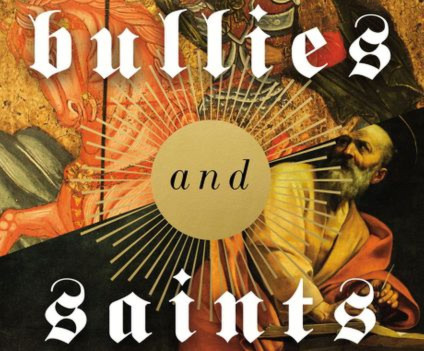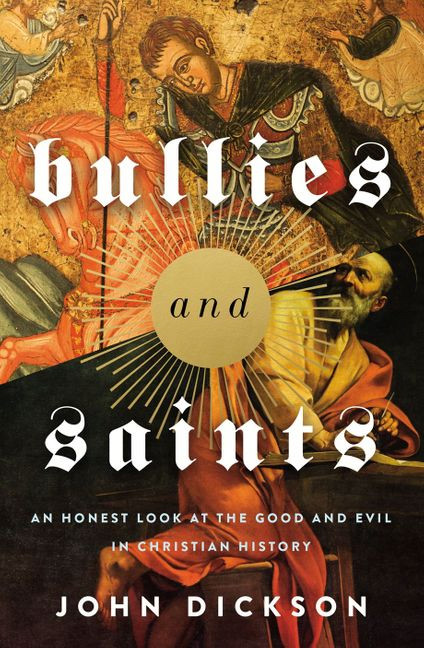
DAVID ADAMS reads Australian historian John Dickson’s latest book on Christian history…
John Dickson
Bullies and Saints: An Honest Look at the Good and Evil of Christian History
Zondervan, Grand Rapids, Michigan, 2021
ISBN-13:978-0310119371

“The book…works chronologically through the past 2,000 years of history (although he actually first delves into a potted history of the crusades before then diving back into time to the earliest days of the church) to take a look at some of the key figures and moments in the history of the church and assess how well they stack up against two key Christian ideas – that of love (as explained by Jesus Christ in the Sermon on the Mount) and that of the imago Dei, the concept that every person is created in the image of God.”
Australian Christian historian John Dickson likens the history of the church to its success in the performance of a song written by God. “Jesus wrote a beautiful composition,” he writes in one of the early chapters of his latest book, Bullies and Saints. “Christians have not performed it consistently well. Sometimes they have been badly out of tune. Occasionally they have played something entirely different.”
That performance – how well or poorly the church as a whole as well as Christians individually have played Christ’s song down through the 2000 years since He walked the Earth in physical form – is the subject of Bullies and Saints.
The book, which follows Dickson’s recent involvement in the Center for Public Christianity’s film series, For the Love of God: How the Church is Better And Worse Than You Ever Imagined, works chronologically through the past 2,000 years of history (although Dickson actually first delves into a potted history of the crusades before then diving back into time to the earliest days of the church) to take a look at some of the key figures and moments in the history of the church and assess how well they stack up against two key Christian ideas – that of love (as explained by Jesus Christ in the Sermon on the Mount) and that of the imago Dei, the concept that every person is created in the image of God.
In its pages we meet Christians like St Boniface, a missionary monk who used persuasion rather than force to reach the Germanic warrior tribes in the 8th century, the Benedictine Abbess Hildegard who was a leader in bringing renewal to the church and Alcuin of York, an 8th century Christian scholar and teacher from York, England, who was “arguably the greatest European you’ve never heard of” . But we also meet the likes of Bishop Cyril of Alexandria, an “imperious leader” in the Egyptian city of Alexandria who supporters ended up killing a star philosopher named Hypatia in 415 AD, and St Bernard of Clairvaux, among those during the Crusades making the case for “holy war”.
The contrast between the saints and bullies can be seen clearly in the first half of the book when Dickson draws a direct comparison between St Ambrose of Milan and Gregory of Nyssa. Contemporaries in the fourth century, both men were fervent Christians yet the paths they choose in exercising that couldn’t have been more different. While St Ambrose was a former Roman Senator and governor who epitomised what Dickson calls “muscular Christianity”, Gregory of Nyssa was one of the “intellectual giants of early Christianity” who in one sermon “left us with history’s first full-throated attack on the practice of slavery”.
“Gregory and Ambrose were both great men,” writes Dickson, having moments before noted that Gregory preached his sermon on slavery probably around the time Ambrose was cross-examing heretics, leading protests to prevent imperial use of church buildings and complaining over Christians having to pay for a synagogue they burnt down. “For me, one embodied the very essence of Christ’s teaching. The other was as quintessentially Roman as he was Christian.”
One of the fascinating aspects of a book like this is the stories it illuminates of those in the history of the church whose lives are not so well known. Among them in this instance is Eligius, who lived from 590 to 660 AD in France, and who was famous for not only making fine jewellery (which he would wear and then give away) but also for freeing slaves. And then there’s Christina “the Astonishing”, a Belgian-born woman who in the 12th and early 13th centuries believed her mission was to save others through her preaching and her own suffering.
The first half of the book charts in detail the move of the Christians from being what Dickson terms “good losers” in the first few centuries of the church to – with thanks in part to the famed Emperor Constantine – finding themselves in positions of power, influence and wealth. We reach the time of the Crusades of the 10th and 11th centuries and then, in the book’s second half, things pick up speed as Dickson delves into subjects including the Inquisition as well as the Reformation and the Thirty Years War, before touching on more recent events such as the Troubles of Northern Ireland (as well as an interesting discussion on the term ‘Dark Ages’).
Of course, a book of only 280-odd pages (plus notes) which spans some 2,000 years of history has to be selective – there’s only passing reference to the Celtic church, for example – while the broad focus is very much on Western Christianity (although there is an informative chapter on the church in the East).
That given, this is, nonetheless, a reasonably wide-ranging, warts-and-all look at the good, the bad and the ugly of Christians in history. And there’s been plenty of all three.
But ultimately, as Dickson points out in the closing pages, it’s about the performance, not the song.
“Jesus Christ wrote a beautiful composition,” he writes in the closing pages, repeating his words from earlier on. “Christians have not performed it consistently well. Sometimes they were badly out of tune. But the problem with a hateful Christian is not their Christianity but their departure from it…Christ’s melody remains beautiful – dare I say unique. And when Christians perform it, they leave an indelible mark on the world.”





